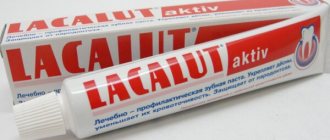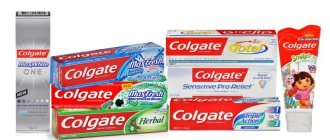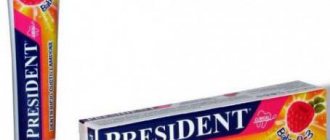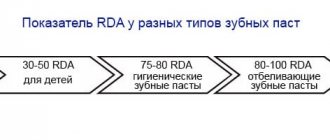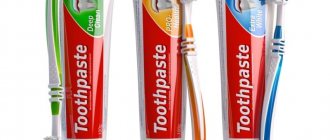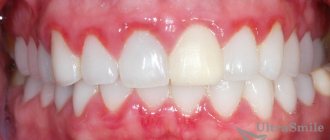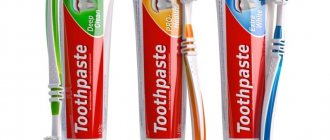The best toothpaste without fluoride: composition
First, I would like to say a few words about fluoride-free toothpastes, which we conventionally classify as “outdated generation.” The fact is that they have a much lower price - in comparison with high-quality toothpastes based on real medical nano-hydroxyapatite (nHAP). We have already said above that the simplest toothpaste without fluoride will contain one of the following compounds:
- calcium glycerophosphate,
- calcium lactate,
- calcium pantothenate,
- calcium citrate,
- calcis®.
Important: the highest quality 1st generation fluoride-free toothpastes will contain the combination “calcium glycerophosphate + magnesium chloride” (this combination is patented as Mineralin ® and is used in ROCS toothpastes). The fact is that magnesium ions are able to activate the work of metal-dependent enzymes (acid and alkaline phosphatases), on which the efficiency of hydrolysis of calcium glycerophosphate into active calcium ions and phosphates depends.
In turn, SPLAT toothpastes contain a patented compound - Calcis ®, which is a complex of calcium compounds obtained from eggshells. It includes the water-soluble calcium dihydrogen phosphate, acetate, lactate, succinate, citrate and tartrate. However, neither Mineralin® nor Kaltsis® will make toothpaste without fluoride even close to the anti-caries effectiveness of toothpastes with fluoride or nano-hydroxyapatite. Therefore, they are best used only in children aged 0 to 6 years (and only in those who have the lowest risk of developing dental caries).
Features of the action of hydroxyapatite
Hygiene products use Hydroxyapatite SP-1, a natural mineral substance that makes up 70% of human bone tissue, including tooth enamel. Thanks to this feature, the mineral is widely used to restore bone tissue. When making dental prostheses from it, it is possible to avoid rejection of synthetic materials by the body.
The first research on hydroxyapatite began in Japan in 1970. After 10 years, the component began to be used in toothpastes. Although the widespread use of the active substance began only in 2000. It is actively used in the restoration and treatment of enamel. This became possible due to a number of beneficial properties of the mineral:
- Replenishes missing mineral elements.
- Fills microcracks, makes the surface even and smooth.
- Treats caries and prevents its development.
- Reduces sensitivity to food in contrasting temperatures.
The component is absolutely safe. It can be used in hygiene products for children and pregnant women.
The most modern and effective calcium compounds in fluoride-free toothpastes:
Of the compounds listed below, the palm can be given to two components: 1) synthetic medical nano-hydroxyapatite (nHAP), but subject to its correct concentration and correct particle size, 2) amorphous calcium phosphate associated with casein phosphopeptides (CPP-ACP). However, we will describe other compounds such as tricalcium phosphate (TCP) as well as Novamin®.
Medical nano-hydroxyapatite (nHAP) –
Hydroxyapatite (synonym: calcium phosphate hydroxide) is a stable and biocompatible calcium phosphate with low solubility, which is used in dentistry to remineralize teeth, reduce their sensitivity, and also for teeth whitening. It is almost exactly the substance that makes up tooth enamel. Medical nano-hydroxyapatite (nHAP) was developed in 1970 by the American agency NASA for astronauts to replenish the amount of minerals in their teeth and bones lost in conditions of weightlessness.
The first commercial toothpaste based on nHAP was developed in 1978 by the Japanese. Currently, the company's Apagard® and Apadent® toothpastes contain nano-mHAP ® (a patented form of nano-hydroxyapatite with a particle size of 8 to 40 nanometers). Now many similar products with hydroxyapatite have appeared in the world and in Russia, but as you will see below, most of them do not have a very good composition and low efficiency.
The effectiveness of hydroxyapatite paste is affected by:
- Hydroxyapatite particle size – hydroxyapatite in toothpastes comes in 2 varieties. The best option is nano-hydroxyapatite (nHAP), whose particles are up to 100 nanometers in size. But most often, toothpaste contains the most common hydroxyapatite (HAP), the particles of which are only micro-sized - up to 5-10 microns in diameter. However, the granulometric composition shows that only particles with a diameter of up to approximately 1-3 microns demonstrate reliable adhesion to the enamel surface, which cannot be said about larger hydroxyapatite particles (source).
Thus, the smaller the particle size, the easier they adhere to the surface of the enamel, the more significant a protective layer they will form on its surface, the more effective the remineralization of teeth will be, the higher the protection against caries will be, the faster tooth sensitivity will disappear, and also, the lower the rate of plaque formation will be. Thus, the particle size of hydroxyapatite is one of the most important criteria for its effectiveness in toothpaste (or mouthwash).nHAP particles up to 50 nanometers will penetrate as deeply as possible into demineralized areas of enamel, as well as micro-cracks - as if filling them. The fact is that tooth enamel consists of so-called enamel prisms (the distance between which is 50 nanometers), as well as interprismatic substance. When enamel demineralizes, it is the interprismatic substance that dissolves first of all, which is physiologically less mineralized. Therefore, nHAP particles up to 50 nanometers are able to penetrate deeply into areas of demineralization.
Microscopy of tooth enamel –
According to the scientific work “Evaluation of the effectiveness of long-term use of Apadent Total Care toothpaste containing medical nano-hydroxyapatite” (authors Makeeva, Polyakova, etc.), the use of paste with nano-hydroxyapatite particles from 8 to 40 nm led to complete remineralization of artificially created foci of dental demineralization enamel – in just 1-3 days. Such small particles are able to immediately penetrate deep into the enamel - even at the earliest stages of development of foci of demineralization.
Important: scientific work confirms that toothpastes with nano-hydroxyapatite particles of any size (even larger ones from 50 to 100 nanometers) have more significant remineralizing and anti-caries effects than toothpastes with non-nano-sized hydroxyapatite particles. This is due to the fact that hydroxyapatite nanoparticles have a higher degree of hydrophilicity and adhere to the enamel surface much more easily than micro-sized hydroxyapatite particles. Consequently, nano-hydroxyapatite will form a layer on the surface of the enamel, which will adhere more firmly to the tooth structure (24stoma.ru).
- Concentration of hydroxyapatite in toothpaste - scientific studies demonstrate that the effectiveness of hydroxyapatite has a clearly defined dependence on its concentration in the composition of the product (source). Experimental data show that increasing the concentration of hydroxyapatite from 1 to 10% led to an increase in the coverage area of the enamel surface from 10 to 32%. Thus, when using products with 1% hydroxyapatite, only 9.6% of the enamel was covered with a layer of hydroxyapatite; when using 5% hydroxyapatite – 13.4% of the enamel surface; when using 10% hydroxyapatite - 32% of the enamel surface area (see figure below).
Please note that these figures were obtained using micro -particles of hydroxyapatite, and not nano-particles. The scientific work mentioned above also discusses the fact that the smaller the hydroxyapatite particles, the better they will adhere to the enamel surface. Thus, if we use nano -hydroxyapatite, it will form a protective layer over a much larger area of the tooth surface (and the thickness of this layer will be greater) - than when using the same concentration of hydroxyapatite microparticles.
But let's move from numbers to real clinical effectiveness, and try to measure it. Scientific research will help us with this, allowing us to compare the effectiveness of tooth remineralization when using toothpastes with different compositions. The scientific study “Comparative effectiveness of hydroxyapatite and fluoride toothpaste for the prevention and remineralization of caries in children” (authors Bennett T. Amaechi, et al.) - shows the clinical effectiveness of 10% nano-hydroxyapatite at the level of fluoride toothpaste containing 500 ppm amino fluoride. Elmex fluoride children's toothpaste was used for comparison.
Other studies, such as King et al. (2006) - it was found that 10% nano-hydroxyapatite has only a slightly less remineralizing effect than toothpaste with 900 ppm sodium fluoride. We will take the average between these two studies as a basis, and will assume that 1400-1450 ppm of fluoride in toothpaste for adults is considered the standard for anti-caries protection. Thus, it turns out that the effective concentration of nano-hydroxyapatite should be at least 15-20% (with nHAP particle size from 50 to 100 nanometers). But for toothpastes with even smaller nHAP particles up to 50 nanometers, 2 times lower concentrations will be effective.
Important: our editors do not consider it possible to trust Russian toothpastes where the manufacturer simply states: “contains hydroxyapatite”, “contains nano-hydroxyapatite”, “contains hydroxyapatite particles of different sizes” - where neither the concentration nor the size of the particles are indicated at all. After all, if toothpaste contains ordinary hydroxyapatite (with a particle size of more than 1-3 microns, which do not stick to the enamel surface at all), then these particles can only serve as an abrasive. The correct concentration and particle size of hydroxyapatite are competitive advantages that set the product apart from the rest. And if the manufacturer refuses on principle to disclose this information, we draw quite logical conclusions. Therefore, it is best to buy those toothpastes where the manufacturer has clearly indicated that it uses nano-hydroxyapatite, as well as its concentration.
Tricalcium phosphate (TCP) –
Tricalcium phosphate (TCP) is indeed used in a number of fluoride-free toothpastes, but it is also much less effective than nHAP or CPP-ACP toothpastes. Therefore, it is better not to use toothpastes that contain only TCP, but you can use those that contain TCP in combination with hydroxyapatite (for example, Korean toothpaste Dr.EL Shirin Care).
Toothpastes containing tricalcium phosphate in combination with fluorides will have an even higher effect of remineralizing teeth. An example of such a paste is “ CLINPRO tooth cream ”, which contains tricalcium phosphate + 900 ppm sodium fluoride (produced by one of the most famous manufacturers of dental materials in the world - American).
NovaMin® (calcium and sodium phosphosilicate) –
NovaMin® is nothing more than “calcium sodium phosphosilicate”, which is used in toothpastes usually in a concentration of 5%. To put it in simple language, this is synthetic bioactive glass. When toothpaste comes into contact with saliva, calcium phosphate is deposited on the surface of the tooth enamel, which will gradually transform into hydroxyapatite crystals. But it must be said that calcium and sodium phosphosilicate is certainly less effective - in comparison with toothpastes based on nHAP or CPP-ACP.
The scientific study “In Situ Study to Confirm the Anticaries Potential of a Sodium Monofluorophosphate Dentifrice Containing Calcium Sodium Phosphosilicate” (authors Parkinson C., Siddiqi M.) suggests that adding calcium and sodium phosphosilicate to fluoride toothpastes did not increase and did not reduce the remineralizing potential of these toothpastes. Those. when adding 5% calcium and sodium phosphosilicate to the toothpaste with 1450 ppm fluoride, its effectiveness remained at the same level as if the toothpaste contained only 1450 ppm fluoride.
Recaldent™ (CPP–ACP) –
One of the best components for mineralization/remineralization of teeth, as well as reducing the risk of caries, is “Amorphous calcium phosphate bound to casein phosphopeptides” (CPP-ACP). This component is patented under the name Recaldent™, and its effectiveness is not inferior to toothpastes with nano-hydroxyapatite (nHAP). The only point is that products with CPP-ACP are usually produced only for applications on teeth, and not for brushing teeth. This is due to the fact that there are a number of studies showing that abrasives in toothpastes significantly reduce the deposition of amorphous calcium phosphate on the surface of tooth enamel.
An example of a product is fluoride-free dental gel “ GC Tooth Mousse ” (made in the USA). This drug contains the CPP-ACP complex as well as xylitol. The drug is used 1-2 times a day for applications on the teeth for 3-5 minutes (in adults and children over 3 years old). There is also an even more effective version of this product - the GC MI Paste Plus , but it already contains a combination of CPP-ACP and 900 ppm sodium fluoride. It should also be taken into account that products with the CPP-ACP complex can cause allergies in patients with milk protein intolerance, because Casein phosphopeptides are produced from cow's milk.
Fluoride-free toothpastes for children –
The enamel of children's teeth after they erupt contains very little calcium, i.e. is low-mineralized. Such porous enamel is very vulnerable to the effects of cariogenic bacteria in the oral cavity, and therefore children's teeth are especially quickly affected by caries. Toothpastes with fluoride protect teeth well from caries, but if you need to choose a toothpaste without fluoride, the latter must contain calcium. The best calcium compound in children's toothpastes is nano-hydroxyapatite.
In the ranking of fluoride-free toothpastes for children, in our opinion, the undisputed leader is the PRESIDENT line of Italian toothpastes. As you will see below, these pastes have an excellent composition and a very reasonable price. Also, in our opinion, SPLAT pastes are very interesting - due to the content of a complex of lactic enzymes that protect the mucous membrane from stomatitis and thrush.
Biorepair Kids toothpaste with strawberry flavor (from 0 to 6 years) –
- manufacturer: Italy,
- active substances – 15% nano-hydroxyapatite (MicroRepair®), zinc ions,
- abrasiveness – RDA 14.7,
- without fluoride, lauryl sulfate and parabens,
- 50 ml tube – from 350 to 400 rubles.
Comments: Biorepair Kids toothpaste contains 15% nano-hydroxyapatite (MicroRepair® particles, which, as we established above, range in size from 50 to 100 nanometers). In our opinion, this is the best fluoride-free children's toothpaste intended for children from 0 to 6 years old. In addition, the paste contains natural strawberry extract and is absolutely safe if swallowed. Zinc ions have a mild antibacterial effect. High degree of protection against caries and remineralizing effect (which will be even higher if you sometimes combine it with fluoride toothpaste). There is also a little bonus inside the package - a coloring book for children.
A slightly less effective analogue of this toothpaste is KAREX Kihder toothpaste (Germany), which contains micro-sized hydroxyapatite particles. The concentration of hydroxyapatite in this toothpaste is 10%, and its anti-caries effectiveness will be lower than that of Biorepair Kids.
Toothpaste ROCS PRO Kids “Wild Berries” (from 3 to 7 years) –
manufacturer – Russia,- active ingredients – hydroxyapatite, calcium glycerophosphate, magnesium chloride, 10% xylitol, honeysuckle extract,
- RDA - not specified,
- without fluoride, lauryl sulfate and parabens,
- the price for a 45 g tube is about 270 rubles.
Comments: a good toothpaste from a Russian manufacturer, which contains hydroxyapatite microparticles. In addition, the manufacturer cunningly indicated that a 50% hydroxyapatite suspension was used in the production of the toothpaste, but you should understand that this has nothing to do with the percentage of hydroxyapatite in the toothpaste itself (by the way, the manufacturer does not disclose it). The paste also additionally contains calcium glycerophosphate, as well as magnesium chloride, which accelerates its decomposition with the release of active calcium ions. The xylitol content is certainly also a big plus, and honeysuckle extract will have a slight anti-inflammatory effect.
Toothpaste SPLAT Baby “apple-banana” (from 0 to 3 years) –
instructions for use- manufacturer: Russia
- contains – hydroxyapatite, L-arginine, milk enzyme complex (lactoferrin, lactoperoxidase, lysozyme, glucose oxidase), licorice extract, Aloe Vera gel,
- without fluoride, lauryl sulfate and parabens,
- price: tube 40 ml – from 150 rub.
Comments: toothpaste for children from 0 to 3 years old with apple-banana flavor. Contains a small concentration of hydroxyapatite, and in terms of the remineralizing effect, this toothpaste will be significantly inferior to the first two. An absolute plus of this paste is that it contains a complex of lactic enzymes, which increases the local immunity of the oral mucosa, which will prevent the development of herpetic stomatitis, as well as oral thrush.
This paste also contains a large amount of plant extracts and L-arginine, which reduce inflammation of the mucous membrane during teething. The paste is completely safe if accidentally swallowed. The paste kit includes a silicone finger brush. In general, this is a very worthy toothpaste for children, but in terms of the effect of remineralization and protection of teeth from caries, it is weaker than the first two. But this paste is stronger in terms of preventing stomatitis and fungal infections of the oral cavity in children, and it also reduces unpleasant symptoms during teething.
The most effective toothpastes -
True, in this section we will talk about toothpastes that contain both calcium and fluoride. Yes, it is fluoride, but this information will be useful to you. Moreover, if we are talking about toothpastes with outdated calcium compounds (for example, calcium glycerophosphate), then calcium and fluoride in one tube is not very good. Scientific research shows that in this case, the presence of calcium reduces the concentration of active fluoride ions - to approximately 50% of their declared content in the tube.
However, at the moment, modern technologies make it possible to stabilize the simultaneous content of fluorides - together with nano-hydroxyapatite (nHAP), tricalcium phosphate (TCP), as well as amorphous calcium phosphate associated with casein phosphopeptides (CPP-ACP). Casein phosphopeptides can also act as calcium and fluorine stabilizers. For example, in this case, amorphous calcium phosphate associated with casein phosphopeptides and fluorine will have the abbreviation CPP-ACPF.
So, any of these calcium compounds, stabilized with fluoride, will be more effective in terms of mineralization and protection of teeth from caries than any modern calcium compound without fluoride (even if we are talking about CPP-ACP, nHAP). Therefore, if the absence of fluoride in toothpaste is not your fundamental requirement, it is better to choose medicinal toothpastes for caries that contain both fluoride and calcium (see the link below). And if the requirement for the absence of fluoride is strict, then it is better to choose a toothpaste with nano-hydroxyapatite, or a tooth gel with CPP-ACP.
→ Therapeutic toothpastes and gels for caries
Toothpastes that reduce tooth sensitivity
Toothpastes to reduce the sensitivity of tooth enamel contain biologically active components:
- potassium nitrate,
- potassium citrate,
- sodium citrate,
- strontium chloride,
- hydroxyapatite.
SENSODYNE F TOOTH PASTE
Potassium chloride, which is part of Sensodyne F toothpaste, has similar properties.
These compounds, when interacting with the organic substances of the enamel, create a protective barrier that prevents pain reactions to temperature or chemical stimuli (hot, cold, sweet, sour), as well as to mechanical stimuli (when brushing teeth).
Components included in some toothpastes, such as Remodent (3%), calcium glycerophosphate (0.13%), synthetic hydroxyapatite (2 to 17%), help reduce the increased sensitivity of enamel by closing the entrance holes of the dentinal tubules.
This group also includes toothpastes such as Oral-B Sensitive, Lacalut Sensitive.



